Top Blockchain IoT Use Cases Transforming Key Industries
- BLOG
- Blockchain
- November 24, 2025
Connected devices keep multiplying, yet many organizations still struggle with issues like data tampering, unauthorized access, and unreliable system updates. These weaknesses slow operations, create security gaps, and generate costly decision-making errors.
The challenges become even bigger as more IoT devices join networks without transparent oversight or consistent verification. That is where the most effective blockchain IoT use cases make a difference.
When blockchain supports IoT infrastructure, it strengthens data integrity, automates verification, and creates shared visibility across every device interaction. This guide walks you through how blockchain and IoT work together to solve real industry problems and reshape how modern systems operate.
Contents
- 1 What Are Blockchain IoT Use Cases?
- 2 How Blockchain and IoT Integration Works Behind the Scenes
- 3 Key Problems That Blockchain IoT Solutions Help Solve
- 4 Top Blockchain IoT Applications Across Industries
- 5 Blockchain IoT in Healthcare: Secure Patient Data and Remote Monitoring
- 6 Blockchain IoT in Smart Cities: Efficient Urban Infrastructure
- 7 Blockchain IoT in Agriculture: Precision Farming and Food Security
- 8 Blockchain IoT Energy Trading for Decentralized Power Markets
- 9 Blockchain IoT in Manufacturing: Smart Factories and Industry 4.0
- 10 How Smart Contracts for IoT Automate Critical Processes
- 11 Blockchain for IoT Security and Device Authentication
- 12 How Webisoft Helps You Build Reliable Blockchain IoT Applications
- 13 Conclusion: The Future of Blockchain IoT Use Cases
- 14 Frequently Asked Questions
- 14.0.1 1. What are blockchain IoT use cases and why do they matter?
- 14.0.2 2. How does blockchain improve IoT security?
- 14.0.3 3. What industries benefit most from blockchain and IoT integration?
- 14.0.4 4. How do smart contracts automate IoT processes?
- 14.0.5 5. Can blockchain help manage large-scale IoT networks?
- 14.0.6 6. Is blockchain necessary for IoT, or can IoT work without it?
What Are Blockchain IoT Use Cases?
Understanding blockchain IoT use cases starts with understanding IoT itself. Many people know the term but do not fully grasp how these devices work or why their data matters. IoT refers to connected devices that collect and share information across a network.
These include sensors, wearables, appliances, trackers, and industrial machines. They capture data such as temperature, movement, or energy usage to support automation and real time decision making. The challenge is that IoT data grows quickly and becomes difficult to secure when stored in centralized systems.
Blockchain strengthens IoT by storing device data in a decentralized, tamper resistant ledger. Instead of relying on one server, information is shared across multiple nodes, preventing manipulation and improving data accuracy.
This helps all stakeholders access consistent, trustworthy information. Blockchain IoT use cases matter today because organizations now manage huge numbers of connected devices and must secure the data they produce. Combining IoT automation with blockchain reliability creates stronger integrity, better transparency, and safer operations across industries.
How Blockchain and IoT Integration Works Behind the Scenes
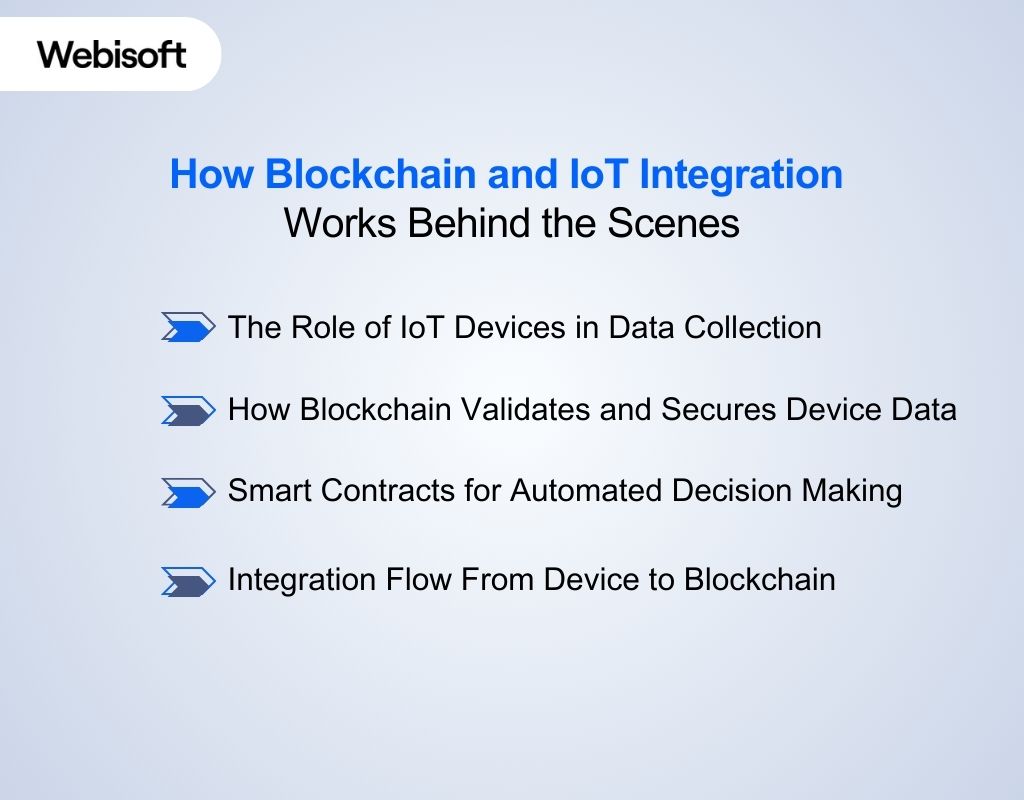 Blockchain and IoT work together by linking connected devices to a decentralized system that validates, secures, and automates data handling. This creates a more trustworthy foundation for real time operations across industries. Below is a clear breakdown of how this integration functions.
Blockchain and IoT work together by linking connected devices to a decentralized system that validates, secures, and automates data handling. This creates a more trustworthy foundation for real time operations across industries. Below is a clear breakdown of how this integration functions.
The Role of IoT Devices in Data Collection
IoT sensors gather live operational data such as temperature, equipment status, energy usage, or shipment conditions. These devices send frequent updates, providing visibility into environments that require constant monitoring and automated decision making.
How Blockchain Validates and Secures Device Data
Blockchain receives sensor readings and stores them as immutable entries. Each record includes a timestamp and cryptographic signature, ensuring data cannot be altered later and remains reliable for compliance or analysis.
Smart Contracts for Automated Decision Making
Smart contracts evaluate sensor data and trigger actions automatically when predefined rules are met. This supports tasks like releasing payments, sending alerts, or adjusting systems without manual review or delays.
Integration Flow From Device to Blockchain
Data moves from IoT hardware to blockchain nodes, where it is verified, stored, and processed by smart contracts. This creates a transparent pipeline that ensures every device interaction is recorded securely and consistently.
Key Problems That Blockchain IoT Solutions Help Solve
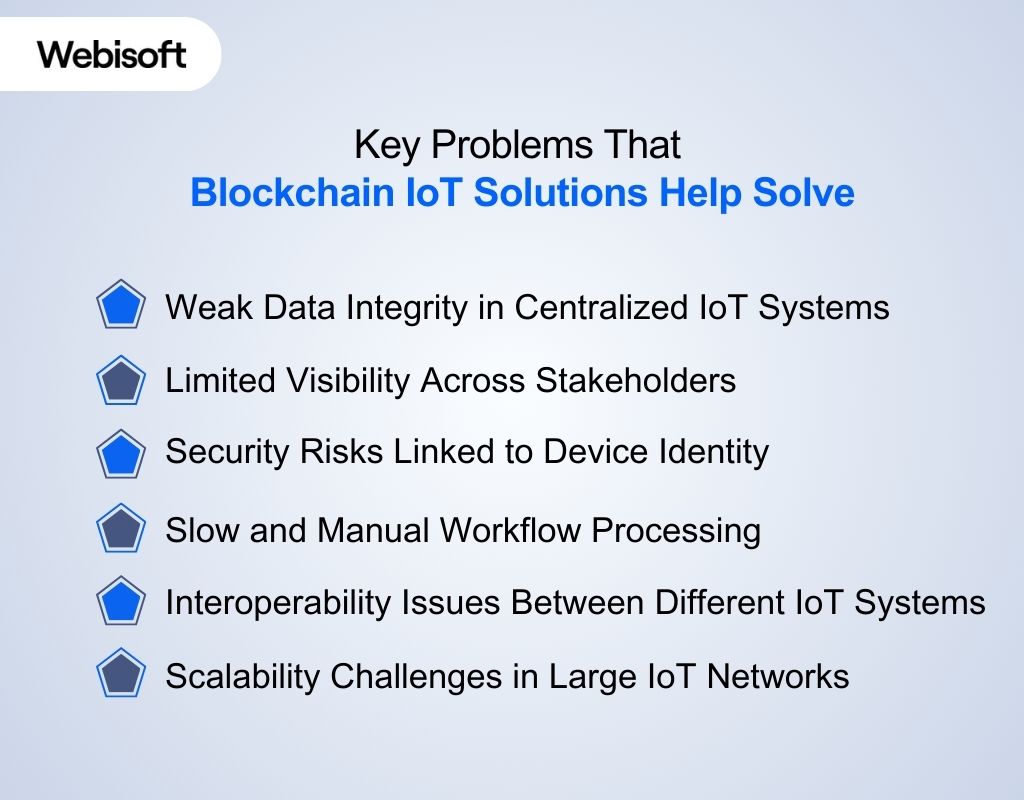 Traditional IoT setups struggle with centralized storage, weak authentication, inconsistent records, and manual workflows. Blockchain IoT solutions address these issues by creating secure, verifiable, and automated environments for connected devices. The following subsections highlight the core challenges blockchain resolves.
Traditional IoT setups struggle with centralized storage, weak authentication, inconsistent records, and manual workflows. Blockchain IoT solutions address these issues by creating secure, verifiable, and automated environments for connected devices. The following subsections highlight the core challenges blockchain resolves.
Weak Data Integrity in Centralized IoT Systems
Central servers make IoT data vulnerable to tampering or accidental loss. Blockchain distributes records across many nodes, preventing silent modifications and ensuring sensor information remains accurate and trustworthy.
Limited Visibility Across Stakeholders
IoT data often stays fragmented between vendors or internal teams. Blockchain gives every participant access to synchronized, verified information, reducing disputes and improving collaboration across shared operations.
Security Risks Linked to Device Identity
Attackers can impersonate IoT devices using weak authentication systems. Blockchain creates verifiable device identities that cannot be easily forged, improving protection against spoofing and unauthorized access.
Slow and Manual Workflow Processing
Many IoT actions depend on manual review, slowing down operations. Smart contracts automate approvals, alerts, and system updates, reducing errors and accelerating response times across workflows.
Interoperability Issues Between Different IoT Systems
IoT devices often use different protocols and platforms. Blockchain provides a unified layer for reliable data exchange, ensuring consistent communication across diverse hardware and software.
Scalability Challenges in Large IoT Networks
As IoT ecosystems grow, centralized systems struggle with rising workloads. Blockchain supports scalable, distributed data handling that accommodates expanding device networks without performance drops.
Unlock the power of blockchain with Webisoft today!
Book a free consultation and build secure, scalable IoT systems backed by blockchain expertise.
Top Blockchain IoT Applications Across Industries
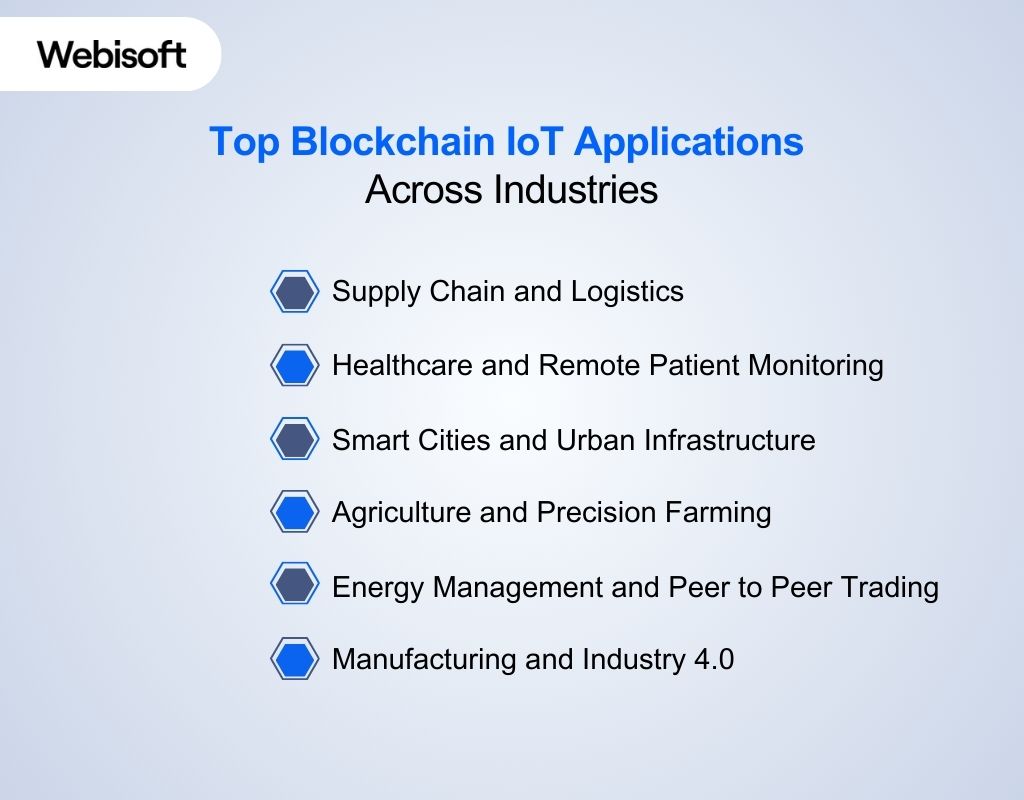 Blockchain IoT applications support many sectors that rely on accurate, real time device data. These combined technologies strengthen transparency, automation, and security across operations. Below are the core industries where blockchain IoT use cases make the biggest impact.
Blockchain IoT applications support many sectors that rely on accurate, real time device data. These combined technologies strengthen transparency, automation, and security across operations. Below are the core industries where blockchain IoT use cases make the biggest impact.
Supply Chain and Logistics
IoT sensors track shipment location, temperature, and handling conditions. Blockchain secures this data, giving partners verifiable records that reduce disputes and ensure products move through the supply chain reliably.
Healthcare and Remote Patient Monitoring
Wearables and medical devices capture patient vitals continuously. Blockchain protects these records from tampering, helping clinicians make informed decisions with accurate, synchronized health data.
Smart Cities and Urban Infrastructure
Traffic sensors, utility meters, and public safety devices generate large data streams. Blockchain preserves data integrity, supporting efficient traffic control, automated waste management, and transparent urban monitoring.
Agriculture and Precision Farming
Sensors in fields track soil moisture, crop health, and climate conditions. Blockchain stores this information securely, allowing farmers, distributors, and consumers to trust the entire farm to table journey.
Energy Management and Peer to Peer Trading
Smart meters measure consumption and renewable energy generation. Blockchain enables automated settlements, decentralized energy trades, and transparent microgrid coordination.
Manufacturing and Industry 4.0
Factories rely on IoT sensors to track machine performance and product quality. Blockchain creates immutable logs for maintenance, compliance, and predictive analytics, reducing downtime and improving efficiency.
Blockchain in Supply Chain IoT: Transparency and Traceability
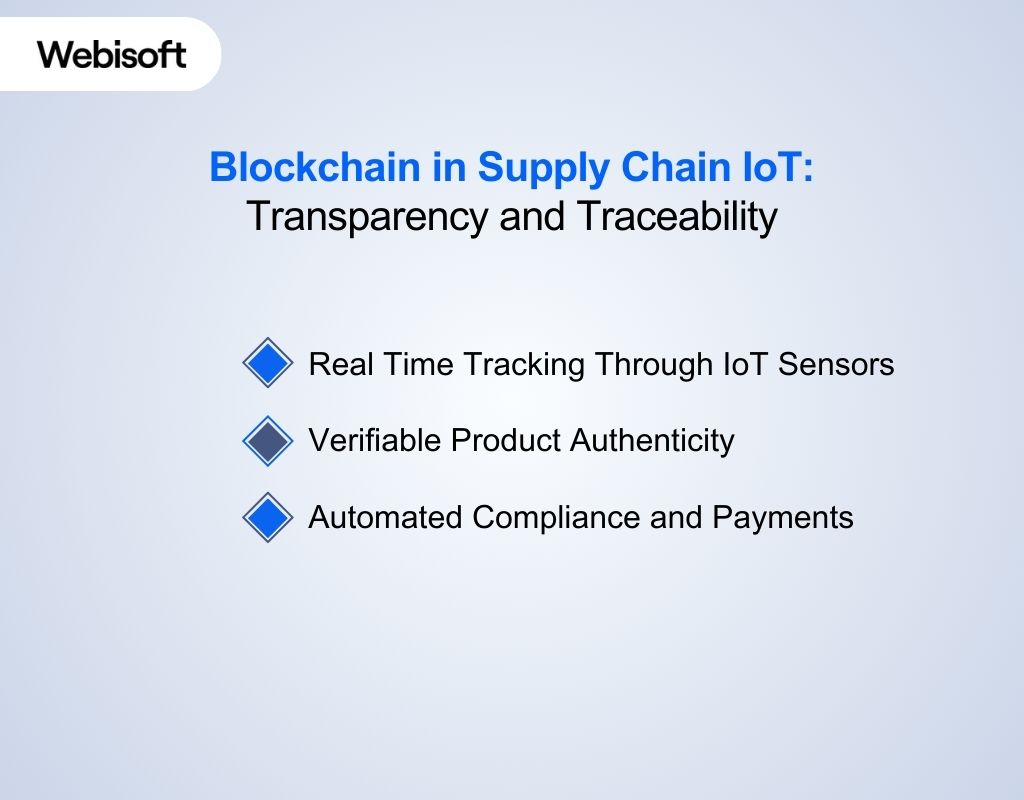 Supply chains rely on trustworthy data to move goods efficiently. Blockchain in supply chain IoT creates a transparent flow of information that strengthens collaboration and reduces disputes across global networks.
Supply chains rely on trustworthy data to move goods efficiently. Blockchain in supply chain IoT creates a transparent flow of information that strengthens collaboration and reduces disputes across global networks.
Real Time Tracking Through IoT Sensors
IoT devices measure temperature, humidity, shock exposure, and location. Blockchain records this information securely, ensuring every stakeholder reviews the same verified conditions from origin to delivery.
Verifiable Product Authenticity
Unique digital identities link products to blockchain records. Anyone can scan a code to confirm authenticity, manufacturing details, and supply chain steps, helping prevent counterfeits and quality issues.
Automated Compliance and Payments
Smart contracts validate delivery milestones and release payments automatically. This removes the need for manual paperwork, reduces errors, and speeds up settlement across shipping stages.
Blockchain IoT in Healthcare: Secure Patient Data and Remote Monitoring
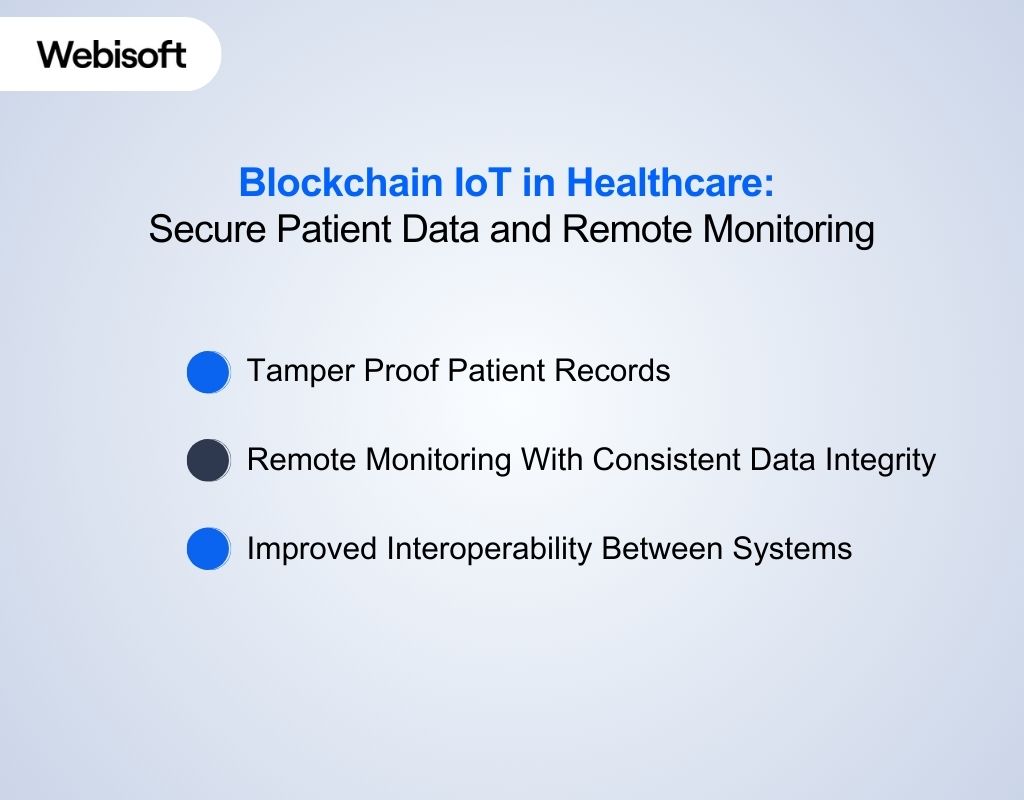 Healthcare relies on accurate data and privacy. Blockchain IoT in healthcare secures information from wearable devices and medical sensors, giving clinicians safer access to real time patient metrics.
Healthcare relies on accurate data and privacy. Blockchain IoT in healthcare secures information from wearable devices and medical sensors, giving clinicians safer access to real time patient metrics.
Tamper Proof Patient Records
IoT devices send continuous health readings to blockchain. Each entry becomes immutable, preventing silent edits and preserving accurate patient histories for long term treatment.
Remote Monitoring With Consistent Data Integrity
Doctors receive reliable data from patient devices, improving oversight for chronic illnesses, medication adherence, and emergency alerts without risking inaccurate or manipulated information.
Improved Interoperability Between Systems
Hospitals and clinics often use different systems. Blockchain creates a shared layer where verified patient data moves securely between providers while preventing record mismatches.
Blockchain IoT in Smart Cities: Efficient Urban Infrastructure
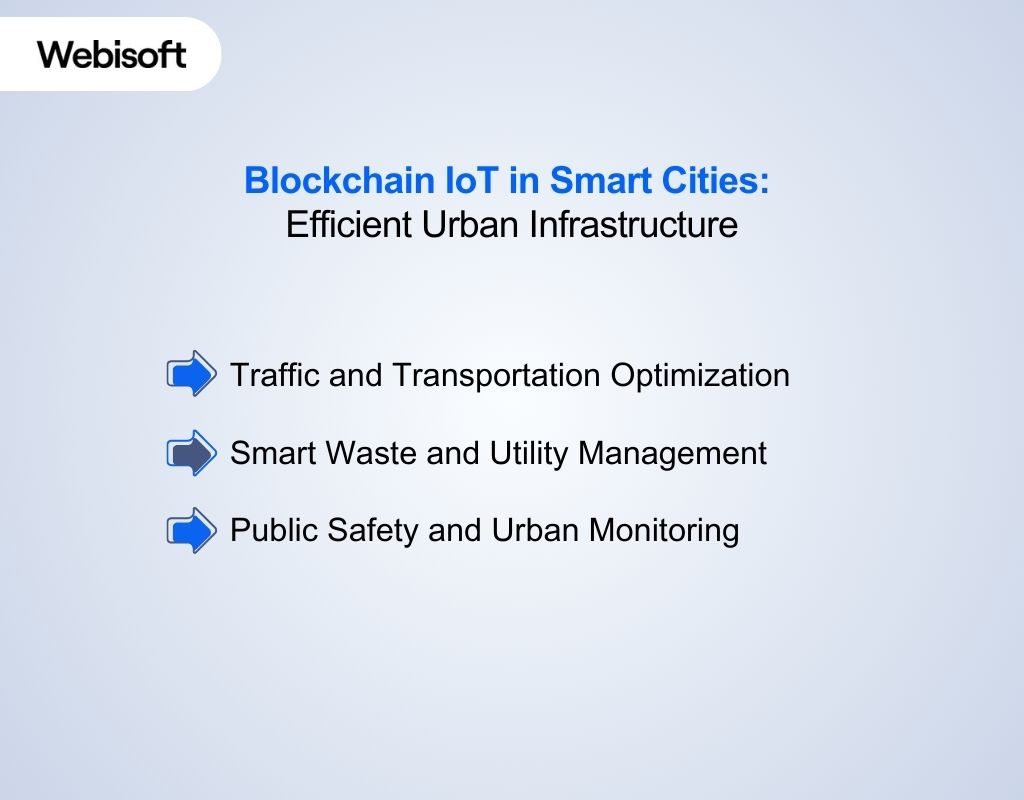 Smart cities run on vast sensor networks that track traffic, utilities, and environmental conditions. Blockchain ensures these readings stay accurate, trusted, and accessible to relevant departments.
Smart cities run on vast sensor networks that track traffic, utilities, and environmental conditions. Blockchain ensures these readings stay accurate, trusted, and accessible to relevant departments.
Traffic and Transportation Optimization
Sensors monitor congestion and signal patterns. Blockchain secures the data so city planners can analyze trends, improve routes, and reduce travel delays with reliable information.
Smart Waste and Utility Management
IoT bins and meters report usage levels automatically. Blockchain preserves these logs, helping teams optimize collection routes, prevent overflow, and maintain fair utility billing.
Public Safety and Urban Monitoring
Cameras and detection devices record events across the city. Blockchain stores these entries securely, supporting transparent investigations and preventing unauthorized data changes.
Blockchain IoT in Agriculture: Precision Farming and Food Security
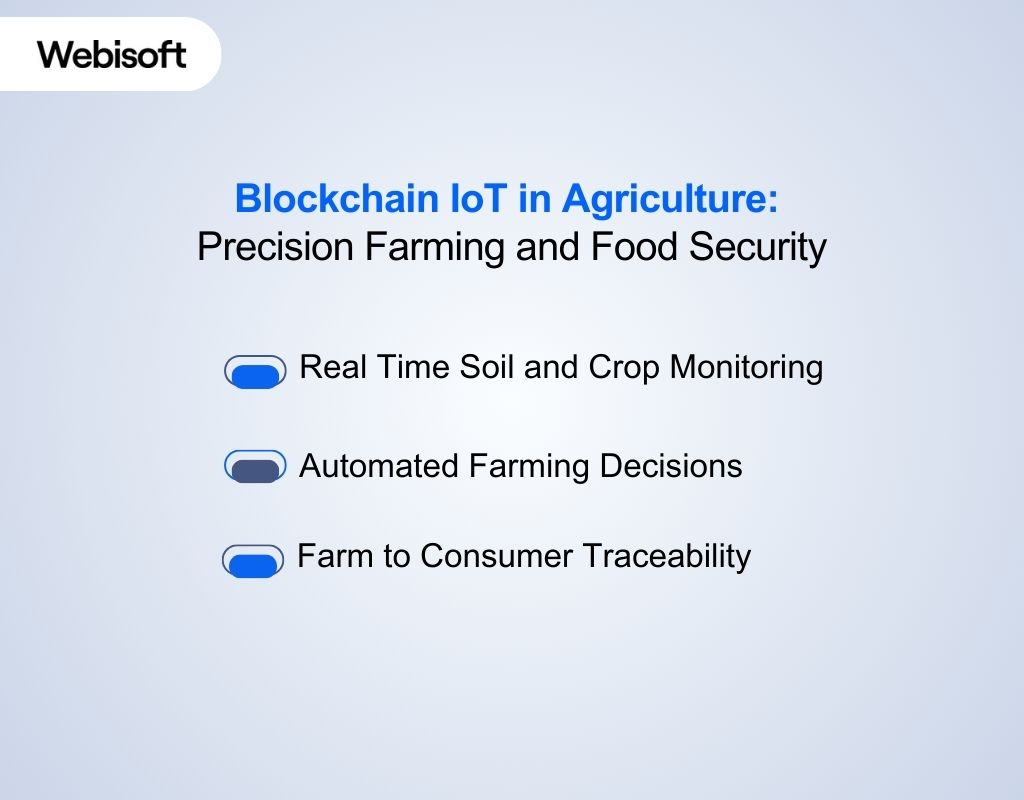 Farmers depend on accurate environmental data to improve yields and resource use. Blockchain IoT in agriculture brings transparency and automation to modern farming operations.
Farmers depend on accurate environmental data to improve yields and resource use. Blockchain IoT in agriculture brings transparency and automation to modern farming operations.
Real Time Soil and Crop Monitoring
Sensors measure soil moisture, weather conditions, and plant health. Blockchain records these values so farmers and partners can rely on verified data for planning and analysis.
Automated Farming Decisions
Smart contracts review sensor readings and activate irrigation, fertilization, or alerts when conditions require action. This reduces manual work and helps optimize resources.
Farm to Consumer Traceability
Blockchain assigns digital identities to produce. Consumers and suppliers verify origin, handling, and harvest dates, improving food safety and strengthening supply chain trust.
Blockchain IoT Energy Trading for Decentralized Power Markets
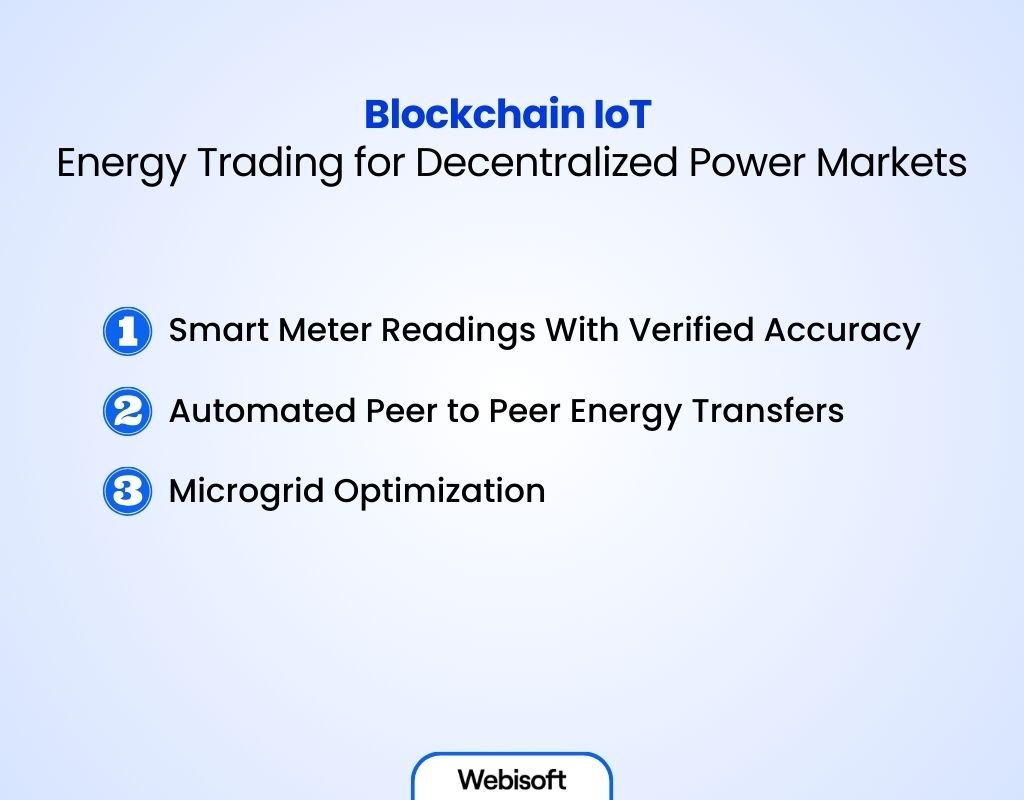 Energy systems are shifting toward local generation and peer to peer trading. Blockchain IoT energy trading supports transparency, fairness, and accurate metering in these new models.
Energy systems are shifting toward local generation and peer to peer trading. Blockchain IoT energy trading supports transparency, fairness, and accurate metering in these new models.
Smart Meter Readings With Verified Accuracy
IoT meters record consumption and generation. Blockchain secures the data, preventing manipulation and allowing energy providers and consumers to trust the results.
Automated Peer to Peer Energy Transfers
Smart contracts match buyers and sellers based on available energy. Transactions complete instantly once conditions align, removing manual coordination.
Microgrid Optimization
IoT sensors balance supply and demand within microgrids. Blockchain maintains transparent logs of distribution, pricing, and settlements for local energy communities.
Blockchain IoT in Manufacturing: Smart Factories and Industry 4.0
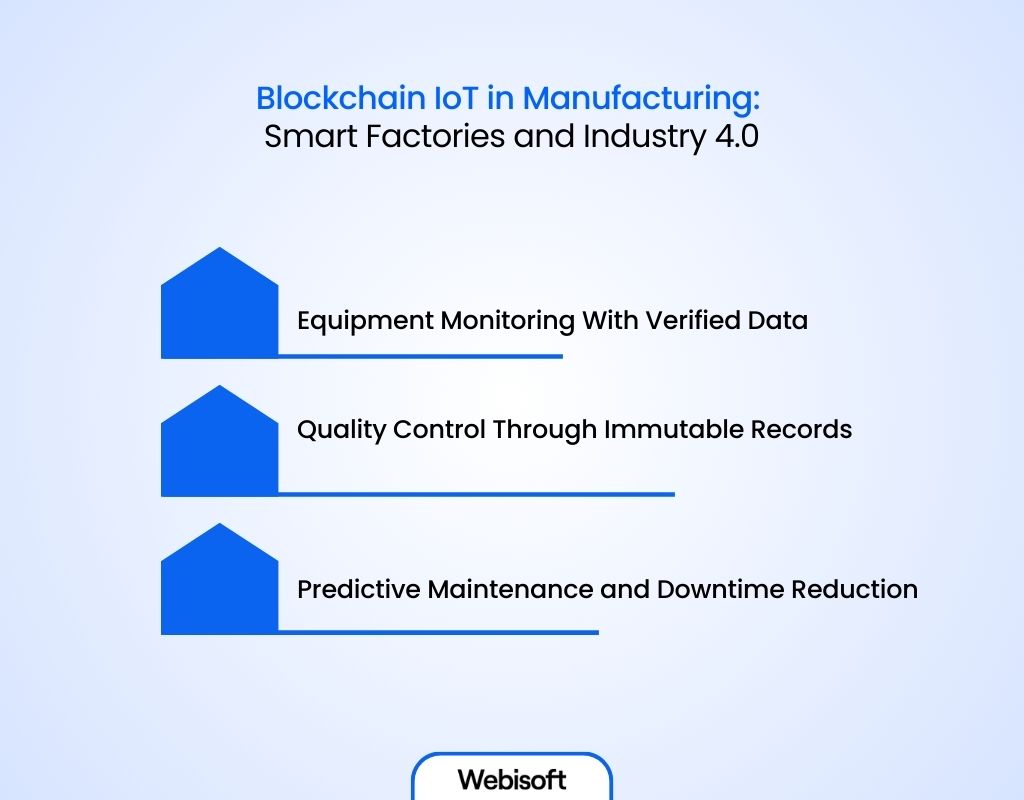 Manufacturing plants depend on accurate machine data, predictive maintenance, and transparent production logs. Blockchain IoT in manufacturing strengthens these systems with reliable records and secure device communication.
Manufacturing plants depend on accurate machine data, predictive maintenance, and transparent production logs. Blockchain IoT in manufacturing strengthens these systems with reliable records and secure device communication.
Equipment Monitoring With Verified Data
IoT sensors track temperature, vibration, and performance. Blockchain secures these readings, helping teams diagnose issues early and maintain accurate maintenance histories for audit requirements.
Quality Control Through Immutable Records
Production data enters the blockchain as items move through each stage. This creates a tamper proof history that improves compliance, reduces errors, and strengthens product validation.
Predictive Maintenance and Downtime Reduction
Smart contracts analyze sensor patterns to detect early signs of equipment failure. Automated alerts help teams schedule repairs before breakdowns occur, improving uptime and production flow.
How Smart Contracts for IoT Automate Critical Processes
 Smart contracts for IoT remove manual steps by responding instantly to device activity. They help organizations execute consistent workflows, reduce delays, and maintain predictable operations across large networks.
Smart contracts for IoT remove manual steps by responding instantly to device activity. They help organizations execute consistent workflows, reduce delays, and maintain predictable operations across large networks.
Automatic Execution Based on Sensor Data
Contracts trigger actions when conditions match device readings. Examples include releasing payments, adjusting system controls, or sending alerts when thresholds reach critical levels.
Reduced Human Errors in Daily Operations
Automation removes the need for manual approvals or data interpretation. This ensures faster, more accurate responses and eliminates common mistakes caused by inconsistent checks.
Transparent and Auditable Process Flows
Every contract action becomes part of the blockchain record. Stakeholders gain clear visibility into when actions occurred, why they triggered, and which device readings initiated the event.
Webisoft helps businesses build secure and scalable blockchain IoT applications that support real time automation, reliable data handling, and seamless device integration. Our team designs smart contract workflows that match your exact operational needs. Book a free consultation with Webisoft today to start building your blockchain IoT solution with confidence.
Blockchain for IoT Security and Device Authentication
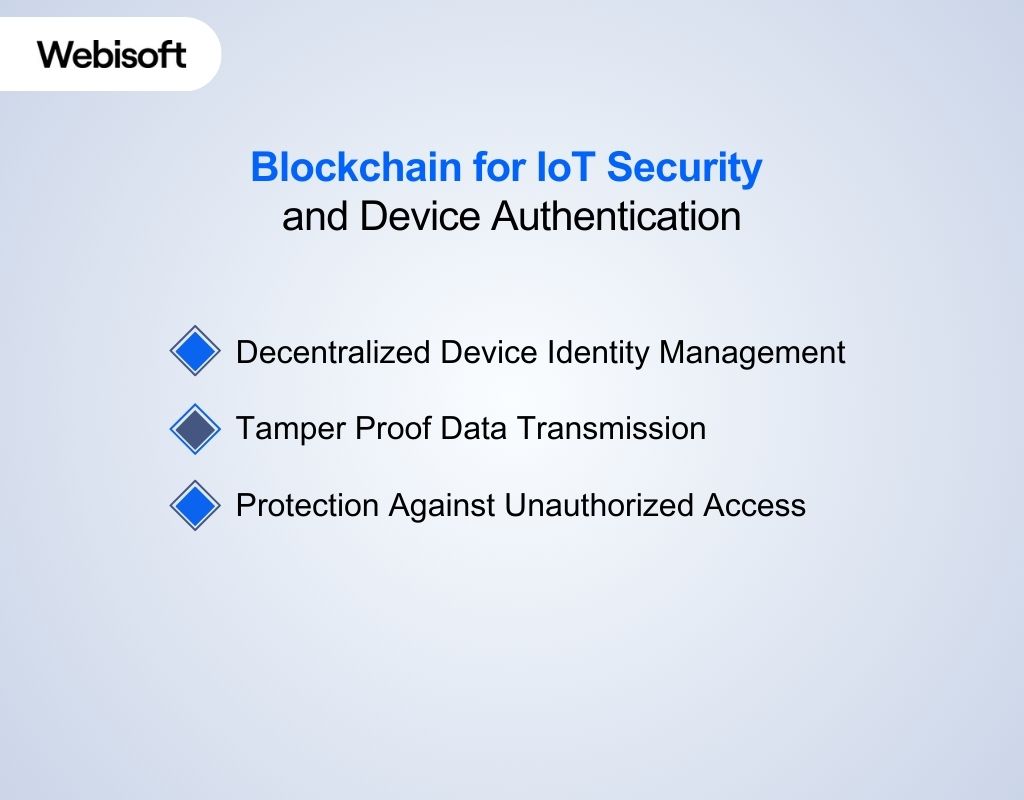 Security remains the biggest challenge in IoT ecosystems. Blockchain for IoT security improves protection by verifying devices, encrypting data, and preventing unauthorized system access.
Security remains the biggest challenge in IoT ecosystems. Blockchain for IoT security improves protection by verifying devices, encrypting data, and preventing unauthorized system access.
Decentralized Device Identity Management
Each device holds a unique blockchain backed identity. This prevents attackers from impersonating devices and submitting false data to critical systems.
Tamper Proof Data Transmission
Information recorded from sensors travels through blockchain secured channels. Data cannot be changed silently, helping organizations trust readings used for safety or compliance.
Protection Against Unauthorized Access
Blockchain distributes authentication records across multiple nodes. This removes the risks linked to centralized servers and strengthens system resilience against targeted attacks.
How Webisoft Helps You Build Reliable Blockchain IoT Applications
 Creating a secure and scalable blockchain IoT system requires expertise in device integration, data architecture, and smart contract development. Webisoft helps you move from early concepts to full production with a process designed for clarity, efficiency, and long term stability.
Creating a secure and scalable blockchain IoT system requires expertise in device integration, data architecture, and smart contract development. Webisoft helps you move from early concepts to full production with a process designed for clarity, efficiency, and long term stability.
End to End Architecture and System Design
Our team evaluates your IoT environment and maps the right blockchain structure for secure data handling, automation, and device coordination across your entire operation.
Smart Contract Development for Automated Workflows
We build smart contracts for IoT that trigger actions, enforce rules, and streamline processes. These automated workflows help you reduce manual work and maintain consistent system behavior.
Integration With Devices, Platforms, and Cloud Systems
Webisoft ensures your IoT devices communicate reliably with blockchain networks. We handle data pipelines, identity frameworks, and system connections for smooth deployment.
Scalability, Monitoring and Ongoing Support
Once your system goes live, our team supports monitoring, upgrades, and improvements to keep your blockchain IoT applications responsive and resilient as your device ecosystem expands.
Unlock the power of blockchain with Webisoft today!
Book a free consultation and build secure, scalable IoT systems backed by blockchain expertise.
Conclusion: The Future of Blockchain IoT Use Cases
Blockchain IoT use cases continue to grow as organizations seek accurate data, secure device communication, and stable automation. By combining blockchain’s trusted records with IoT’s real time visibility, businesses gain a stronger foundation for reliable operations and better decision making.
These technologies now support supply chains, healthcare systems, smart cities, agriculture, manufacturing, and energy networks where trusted data is essential. As you plan your next steps, integrating blockchain with IoT can strengthen efficiency, transparency, and long term security.
If your goal is to build a secure and scalable system ready for real world use, the right team can guide you from planning to deployment with confidence.
Frequently Asked Questions
1. What are blockchain IoT use cases and why do they matter?
Blockchain IoT use cases describe ways blockchain secures, validates, and automates data from IoT devices. They matter because connected systems produce large amounts of sensitive data that need accuracy, transparency, and tamper proof storage.
2. How does blockchain improve IoT security?
Blockchain improves IoT security by creating decentralized device identities, encrypting sensor data, and preventing unauthorized access. This removes single points of failure and ensures device information remains authentic and unaltered.
3. What industries benefit most from blockchain and IoT integration?
Industries such as supply chain, healthcare, smart cities, agriculture, energy, and manufacturing gain the most value. These environments rely heavily on real time data, automation, and trusted information across multiple stakeholders.
4. How do smart contracts automate IoT processes?
Smart contracts for IoT run predefined rules when device data meets specific conditions. They automate tasks like payments, alerts, maintenance requests, and system adjustments without human input, improving consistency and reducing errors.
5. Can blockchain help manage large-scale IoT networks?
Yes. Blockchain supports scalability by distributing data storage across multiple nodes. This prevents bottlenecks in large IoT ecosystems and enables secure coordination across thousands or millions of devices.
6. Is blockchain necessary for IoT, or can IoT work without it?
IoT can function without blockchain, but centralized systems often struggle with data integrity, device authentication, and automation. Blockchain IoT solutions help remove these weaknesses by increasing trust, transparency, and system reliability.


